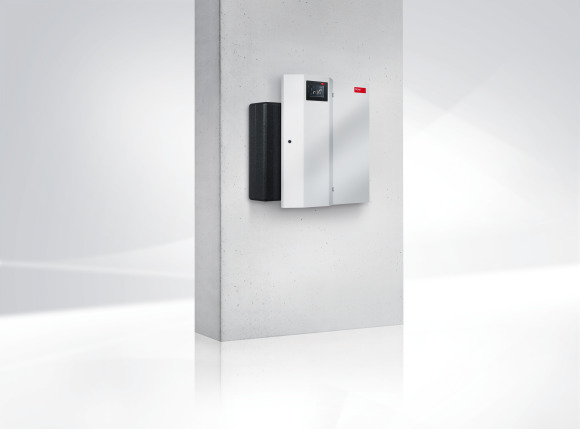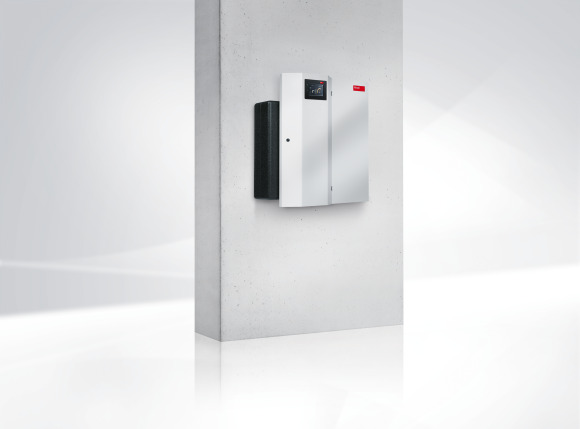District heating. The single-source solution for reliable heat supply.

District heating is the perfect option when it comes to supplying heat to your home. Hoval offers the best district heating solution from a single source.
District heating: Compact, convenient and all from one source.
If you get heating for your home directly from the district heating network, then fuel deliveries and smoking chimneys will be a thing of the past – it’s simple and convenient with incredibly little space required.
A central heating supply via local or district heating networks is used in larger residential complexes and public buildings as well as in single-family homes. The district heating station in the building takes the heating directly from the pipeline and uses it in a highly efficient way for heating the building and water. The combination of a reliable district heating network and a high-tech system in the house ensures maximum operational safety with practically zero expenditure for the homeowner.
The benefit of choosing Hoval: from design and commissioning work to the instrumentation and control system, everything is supplied from a single source, meaning that all components are perfectly coordinated with one another and work with maximum efficiency. The material quality and sophisticated design also help to reduce costs and protect the environment.

Compact and simple
The most convenient way to supply your home with heat: minimal space required, time- and cost-saving installation, practically no maintenance work, simple to use and fully-automated, clean operation.

Custom solutions
The way in which district heating is used can be adapted to the individual requirements of any building and can be integrated into various systems due to the smart control. For efficient complete solutions with an excellent price/performance ratio.

Ecological
Minimal energy usage for maximum heating comfort: district heating networks use a combination of energy from primarily sustainable suppliers, while the building control unit offers excellent thermal insulation and a highly efficient heat exchanger.
We set high requirements and Hoval was able to meet them to our full satisfaction!
What is district heating? How does a district heating system work?

Hoval provides a comfortable level of heat. We’re the expert in heating, ventilation, and climate control technology and will be guiding you step by step.
What do I need to consider when using district heating?
District heating has been tried and tested in cities and urban centres for many years. However, district heating is not available everywhere. In the countryside, the supply network is less dense since long pipelines are associated with energy loss and higher costs. In these cases, local heating networks with short supply lines are increasingly being used. Nevertheless, the district heating network is being continuously expanded with the construction of pipeline networks and the development of new energy sources.
Learn more about the availability of district heating in your region. You should also check whether any minimum purchase quantities that are contractually fixed by the supplier match your energy requirements – particularly if you live in a single-family home in with a low-energy design.

Before you decide on district heating, it is worth finding out more.
Requirements and conditions for the use of district heating
Assuming the most important requirement is met – the availability of a district heating network in your location – there are some additional conditions relating to the connection in the building. For the supply and discharge, bore holes are required in the building envelope and excavation work needs to be completed outside. It is necessary to clarify in advance how the pipelines can be routed and how the system can be connected to the nearest district heating pipeline. District heating pipelines are usually found underground but can also be routed above ground in exceptional cases.
By contrast, the installation of the district heating station in the building is very simple due to the minimal space required and the fully equipped, wall-mounted design that is ready for connection.

The ready-to-connect complete systems from Hoval ensure simple installation.
How much does district heating cost? How is district heating charged?
Connection costs: when setting up the connection in the building, costs are determined by the on-site conditions, such as the distance between the building and the nearest connection point. For a new connection, a one-off fee must be paid, with the suppliers generally co-financing the expansion of the district heating network. The investment costs include the cost of routing the district heating pipelines on the property as well as procuring and installing the heat transfer station in the building.
Operating costs: the monthly costs of obtaining district heating are made up of the basic price of the heat supply and the kilowatt-hour rate for the energy consumed. An integrated meter measures the district heating in kilowatt-hours, with a reading taken from the meter every year. In terms of the overall costs, district heating is a very affordable way to heat a single-family home due to the comparatively low investment and maintenance costs.

If you are new to district heating, many providers charge a one-off connection fee.
TransTherm giro. A reliable basis for every eventuality.

TransTherm giro plus. The compact district heating station.

Is funding available for district heating?




